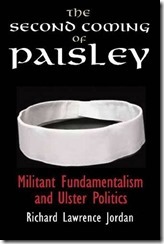 In The Second Coming of Paisley: Militant Fundamentalism and Ulster Politics (Syracuse University Press, 2013), American historian Richard Lawrence Jordan provides us with some insights that are relevant for today – both for understanding the Rev Ian Paisley, and for coming to grips with unionist perspectives on religion and politics.
In The Second Coming of Paisley: Militant Fundamentalism and Ulster Politics (Syracuse University Press, 2013), American historian Richard Lawrence Jordan provides us with some insights that are relevant for today – both for understanding the Rev Ian Paisley, and for coming to grips with unionist perspectives on religion and politics.
With a title like The Second Coming of Paisley, readers might assume this refers to Paisley’s seeming about-face in 2007, when he became First Minister of Northern Ireland after compelling his Democratic Unionist Party (DUP) to share power with Sinn Fein in the Executive of the Northern Ireland Assembly.
But this is not the case. Jordan’s primary focus is on the late 1960s and early 1970s, when, he claims, Paisley became much influenced by American fundamentalism and its response to Martin Luther King Jr and the civil rights movement. Jordan argues that American fundamentalist preachers and political activists ultimately inspired him to take a more pragmatic approach to his religion –thus compromising aspects of his theology for the sake of political gain.
This, of course, allows us to see how Paisley’s latter-day entry into power-sharing is a logical extension of multiple small, ‘compromising’ decisions taken over many years. But unlike some who have studied Paisley, such as sociologist Steve Bruce, Jordan doesn’t see Paisley’s willingness to compromise as somehow exonerating him of responsibility for what other observers feel is a central role in the Troubles. On this, I’ll let Jordan speak for himself (p. 11):
“Without the onset of civil rights activism and O’Neillism, Paisley’s campaigns would have remained religious in focus and the advent of Free Presbyterianism would have been a minor historical incident that linked the Calvinism and revivalism of the British Isles with the militant fundamentalism that emerged in North America. Moreover, without the influence of American militant fundamentalism, there would have been no Paisleyism. Even more important, it is possible to argue that the communal fighting would not have taken place if Paisley had chosen to ignore the Northern Ireland civil rights movement and that civil rights activism would have been less radical if “Paisleyite” activities had not made it difficult for Terence O’Neill to implement political and economic reforms. Without Paisleyism, it is safe to say, the “Troubles” would have unfolded very differently – if they unfolded at all.”
Jordan is not the first scholar to note the links between Ulster and American Protestant fundamentalism. But this is the first book to look at Paisley’s relationships with key American figures in such depth and to argue that Paisley’s observations of the American civil rights movement had far-reaching consequences for his religious/political development. Jordan asserts that:
“Militant fundamentalists argued that a plot existed to use integration, civil rights agitation and black street violence to destroy America’s Protestant churches and establish a godless America” (p. 169) – an argument that sounds very much like what Paisley had to say about nationalism, republicanism, the civil rights movement, Catholicism and ecumenism in Northern Ireland.
Jordan also highlights Paisley’s relationships with segregationists and anti-civil rights campaigners like the Bob Joneses (Chris Donnelly has posted here recently on Ian Paisley Jr’s high regard for the Joneses), General Edwin A. Walker (who utilized John Birch Society material in writing materials for soldiers and advised soldiers how to vote in American elections), and Georgia Governor Lester Maddox, who “had prevented African Americans from eating at his Pickrick restaurant in Atlanta, chasing them into the street with hand guns and ax handles” (p. 193).
Paisley’s Protestant Telegraph reprinted Maddox’s speech to the Christian Crusade convention in 1967, where, Jordan writes:
“Maddox called the racial rioting across American cities a Communist conspiracy abetted by liberals within the US government. By devoting nearly half of his bimonthly eight-page paper to Maddox’s speech, Paisley signalled his whole-hearted endorsement of Maddox’s position and intimated that such a scenario could happen in Northern Ireland if the O’Neill administration did not stamp out the civil rights and Republican movements. It is conceivable that admiration for such Christian politicians strengthened Paisley’s resolve to enter politics” (p. 194).
Further, Jordan shows that Paisley and his American fundamentalist brethren saw themselves on a joint, international crusade against the various forces that would destroy Bible Protestantism if left unchallenged. Paisley’s actions in Northern Ireland, including time spent in jail for disturbing the peace at his pickets, were widely reported among the American fundamentalist press and deemed examples of the persecution of true Christianity.
Jordan also notes that Paisley was attending the annual Bible Conference held at Bob Jones University when Martin Luther King Jr was assassinated. Jordan admits that “Paisley has never publicly stated that the events of the American civil rights movement influenced him” (p. 199). But he argues that after King’s death, Paisley returned to Ulster with a new sense of purpose and was willing to adopt even more militant tactics to ensure that what happened in the US did not happen in his backyard.
Raising awareness of – and questions about – Paisley’s relationships with American fundamentalists is the most valuable contribution of this book.
Beyond that, there is plenty in the book for those looking for deeper historical connections between the US and Ulster.
For example, a major portion of the book is devoted to historical analysis of the development of fundamentalism in both contexts. In this, Jordan painstakingly discusses the influence of Calvinism and revivalism, introducing us to figures such as C.H. Spurgeon, James Glendinning, William Tennett, Henry Cooke, Roaring Hugh Hanna, Charles Finney, Dwight Moody, John Nelson Darby, W.P. Nicholson, J. Ernest Davey, and William Jennings Bryan.
Interestingly enough, Jordan covers some of the same ground traversed in the BBC’s recent documentary, An Independent People: The Story of Ulster’s Presbyterians. In linking Paisley’s career to the wider Ulster-American Presbyterian world, Jordan demonstrates that Paisley should not be seen as an isolated, unrepresentative figure, but rather that he is very much a product of this environment. As Jordan writes: “Paisleyism was the end product of the religious and political history of Ulster outlined to this point” (p. 90).
In the final chapter, titled “The Second Coming: Paisley and the ‘Civil’ Religion of Democratic Unionism,” Jordan turns to more recent history and offers his take on why Paisley seemingly changed his mind in 2007.
As a social scientist (and not a historian), I would have liked to have seen more attention paid to this contemporary period. But after detailing some examples of Paisley and the Democratic Unionist Party’s pragmatism over the years, Jordan agrees with theologian Patrick Mitchel’s argument that “Paisley’s political shift has theological underpinnings” (p. 260).
This follows a line Jordan had taken throughout the book:
Paisley started his public religious life as a “premillennialist,” a theological position that essentially assumes that political action is pointless because God is going to “rapture” away true believers, only to then destroy the world through great tribulations. (For more on the influence of this particular theology on American and Irish thinking, see my post on “Crawford Gribben on Ireland, America and the End of the World”).
But Paisley has now essentially become “amillennialist,” a position which assumes political action can be ordained by God and that changing the world is just as (or more?) important than saving souls. This, Jordan argues, is reflected in the wider world of Ulster fundamentalism/evangelicalism (p. 257):
“[Paisley’s] pragmatism exposed a trend that had been redefining Ulster’s evangelicalism since the revivalism of the nineteenth century: the abandonment of hyper-Calvinism and the acceptance of earthly solutions to man’s depravity and the work of the Holy Ghost.”
The Second Coming of Paisley is well-written and offers some new perspectives on the early career of Paisley, his relationships and influences, and the complex links between religion and politics in the US and Ulster. The book is currently selling for less than £20 on amazon – a bargain by the standards of academic publishing – and is well worth a read.

Gladys is a Professor of Sociology at Queen’s University Belfast and a member of the Royal Irish Academy.
She is also a runner who has represented Ireland and Northern Ireland. She blogs on religion and politics at gladysganiel.com
Discover more from Slugger O'Toole
Subscribe to get the latest posts to your email.